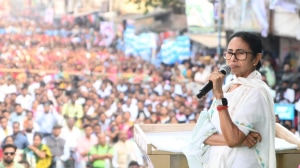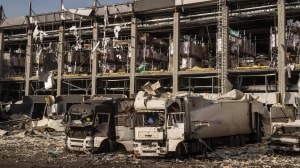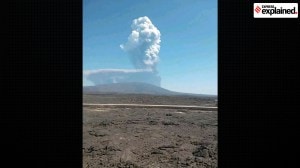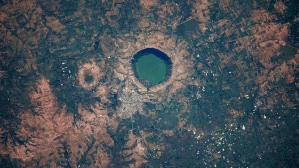2 presidents,1 defining moment
On Sunday,Obama and Bush stood together at the site of the September 11 attackscommanders-in-chief whose terms in office are bookends for exploring how the USs response to terror has changed since September 11,2001
On Sunday,for the first time,US President Barack Obama and former president George W. Bush stood together at the site of the September 11 attacks,listening as family members read the names of lost love ones and bowing their heads in silence to mark the moments the planes hit.
In May,Bush declined Obamas invitation to join him at ground zero after the raid that killed Osama bin Laden. But on this morning,they stood shoulder to shouldercommanders-in-chief whose terms in office are bookends for exploring how the United States has changed since September 11,2001,particularly in its response to terrorism.
The tableau was striking: the president who spent years hunting bin Laden next to the one who finally got him. The president defined by his response to September 11 standing alongside the one who has tried to take America beyond the lingering,complicated legacy of that day.
Unlike Obama,Bush drew a cheer from those who remembered him shouting through a bullhorn atop the smouldering rubble. For Obama,September 11 is perhaps a less wrenching experience,though it underpins what has become one of the great paradoxes of his presidency.
He is a Democratic leader who opposed the Iraq war and is pulling troops out of Iraq and Afghanistan but has notched up a record as a lethal,relentless hunter of terrorists. He is a president who banned torture in the interrogation of suspected terrorists and pledgedunsuccessfully,so farto close the military prison in Guantánamo Bay,Cuba,but carried out more drone strikes in Pakistan in his first year in office than Bush did in his eight years.
In the process,the White House said,it has killed more officials of al Qaeda in the last two and a half years than were eliminated during the entire Bush administration. Among the big names: two top Qaeda managers,Sheik Saeed al-Masri and Atiyah Abd al-Rahman,and one of its most feared field commanders,Ilyas Kashmiri.
We have taken
the fight to al Qaeda like never before, Obama said in his weekly address.
In counterterrorism,there is no question that in Obamas intense use of drones and his laser focus on al Qaeda and its affiliated groups was a departure from the Bush administrations global war on terrorism.
But there has been as much continuity as change in the Obama method,according to terrorism experts. Obama,for example,has continued the full government response to terrorism that the Bush administration eventually adopted. This approachwith the Central Intelligence Agency and Federal Bureau of Investigation working more collaboratively with agencies like the Treasury and State Departments,especially in the fieldculminated in the raid that killed bin Laden.
What youve seen from the Obama administration is fundamental continuity in the counterterrorism policies handed over in 2009,while sharpening the campaign to eliminate core al Qaeda leadership and disrupt safe havens in western Pakistan and Yemen, said Juan Zarate,a top counterterrorism adviser in the Bush administration who has nevertheless criticised the Obama White House for its muddled detention policies.
To be sure,Obama made important refinements and changes. Most notably,he has significantly increased the use of covert and clandestine operations by CIA paramilitary and Special Operations forces from the United States military.
In Obamas first year in office,the CIA carried out 53 drone strikes in Pakistan. The next year,it more than doubled that figure,to 117,according to The Long War Journal,a website that follows the wars in Iraq and Afghanistan. The pace is off a bit this year49 through late Augustbut the drone campaign is spreading to other countries.
The CIA plans to carry out armed drone missions against Qaeda operatives in Yemen,and the military has conducted drone strikes to kill insurgents in Somalia. Stepping up the drone strikes has been a game changer, said Bruce Hoffman,a terrorism expert at Georgetown University. It is frustrating al Qaedas movements enormously.
Still,while Hoffman said that al Qaedas core network had been crippled,its offshoots in Yemen and North Africa continued to put down roots,posing a potentially greater threat to the United States than bin Ladens surviving lieutenants. We can say we turned a corner with al Qaeda, he said,but we cant say we turned a corner in the war on terrorism.
For all its achievements,the administration has also been lucky. A Nigerian man,Umar Farouk Abdulmutallab,almost blew up a Northwest Airlines jet on December 25,2009,with explosives sewn into his underwear. Six months later,a Pakistani-American,Faisal Shahzad,parked an SUV loaded with a bomb that failed to detonate in Times Square.
Obama is rightly proud of his counterterrorism record,but had Umar Abdulmutallab not lost his cool on that plane,he wouldnt have had much of a record to point to, said Bruce O Riedel,a former intelligence officer who has advised the White House. His presidency would have been transformed that Christmas.MARK LANDLER and ERIC SCHMITT



- 01
- 02
- 03
- 04
- 05




























